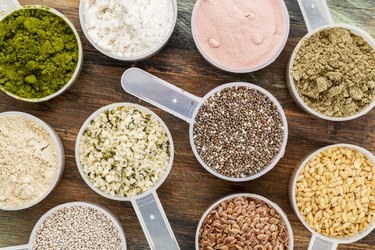
A substitute for whole flaxseed needs to provide easy digestion, be low in calories and provide health benefits to serve as an adequate alternate for the seed.
Image Credit:
Marek Uliasz/iStock/Getty Images
Nutrient packed and prized for its omega-3 content, ground flaxseed should get replaced with food containing healthy fats. A substitute for whole flax seeds needs to provide easy digestion, be low in calories and provide health benefits to serve as an adequate alternate for the seed.
Video of the Day
Video of the Day
Substitute for Flaxseed
According to the USDA, 1 tablespoon of ground flaxseed contains 37.4 calories, less than 3 total lipid fats and almost 2 grams of fiber. For those who prefer a food with a different flavor profile, you can use any of the following as a flaxseed alternative:
- Add a
sprinkling of chia seeds to your cereal, soup or smoothie. Like flaxseed, chia
seeds contain omega-3 fatty acids and serve as a source of fiber, containing 4
grams per tablespoon, per the USDA.
Consuming 2 tablespoons each day will give you almost half of your recommended
fiber intake. In addition, the two types of seeds have
similar textures, and because you'll likely use only a small amount, any
taste differences will be subtle.
As a bonus, according to an April 2016 review of chia seeds from the Journal of Food Science and Technology, this seed offers therapeutic effects, including anti-blood clotting, antidepressant and anti-inflammatory properties and works to improve diabetes control. - Use wheat
germ when baking bread. With a nutty flavor similar to flaxseed and great
binding properties, you can substitute wheat germ for flaxseed when baking. You might, however, notice that your finished product is slightly less chewy than
normal. You will also pick up health benefits. The Whole Grains Council states that wheat germ contains B vitamins, protein, healthy
fats and minerals.
- Use
almond flour in baking. You might need to alter the recipe, as almond flour
often needs a binding agent like an egg. Harvard Health Publishing says that almond flour is a gluten-free
and low-carb alternative. Although offering more nutrients than wheat germ, almond flour comes with more calories and fat. Because this
flour type contains more moisture, you might find your baked goods more apt to
spoilage and mold — be sure to store them in airtight containers. They will store
in the freezer for six to nine months.
- Try substituting each tablespoon of flaxseed in your recipe with one-quarter cup of blended silken tofu to act as a binding agent. According to a January 2018 study on soy foods and their role in vegetarian diets published in Nutrients, researchers found that tofu is one of the best dietary sources of isoflavones, a class of phytoestrogens that help decrease the risk of breast cancer, in human nutrition.
- If you don't prefer tofu, you could substitute half a blended banana, one-third cup of unsweetened applesauce or 3 tablespoons of pureed fruit to work as a binding agent as a ground flaxseed replacement. Any
of these options will give you the same adhering and leavening properties as
ground flaxseed.
- Sprinkle hemp seed on top of salad. Texturally quite different than flaxseed, most find hemp seeds offers a nice, rich flavor. As well as being rich in omega-3s, hemp seeds are a good source of protein and fiber. According to the USDA, hemp seeds provide 9 grams of protein in 3 tablespoons, which is nearly a quarter of its total calories and a great amount more protein than ground flaxseed (which has just a little more than 3 grams per 3 tablespoons). However, hemp doesn't contain the same binding properties as flaxseed, making the plant an unsuccessful replacement in breads or other baked goods.
references
- Harvard Health Publishing: “Almonds”
- USDA: “Hemp Seeds”
- USDA: “Seeds, Flaxseed”
- USDA: “Chia Seeds”
- Journal of Food Science and Technology: “Nutritional and Therapeutic Perspectives of Chia (Salvia hispanica L.): A Review”
- Whole Grains Council: “What’s a Whole Grain? A Refined Grain?"
- Nutrients: "Soy, Soy Foods and Their Role in Vegetarian Diets"